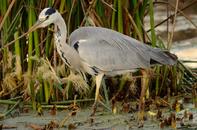
Grey Heron
Name
Grey heron (Ardea cinerea)
Grey Heron Appearance
The grey heron is a tall bird, standing around 1 m tall, but a real lightweight for its size, weighing in at between 1 and 2 kgs. The grey heron is grey on its back and wings, with a “dirty” white underside. The head is white with a black supercilium (eyebrow), with a black crest. The grey heron has dull brown legs and a yellow bill.
Grey Heron Diet
The grey heron feeds on mainly on fish, but will feed on small mammals, insects, molluscs and juvenile birds. Small fish are swallowed head first. Larger prey is first killed on shore before being consumed. Small mammals and birds are often drowned by the heron, before being swallowed whole.
Grey Heron Breeding
During breeding, the grey heron's bill becomes bright orange and the legs become a pink to red colour. The heron is monogamous and will breed in colonies known as heronries. The same nest is used year after year. Three to five eggs are laid and incubated for around 25 days by both parents. The chicks fledge at around 7 to 8 weeks.
Grey Heron Behaviour
The grey heron has a slow and regular flight, with the long neck pulled back in a snake-like “S” shape. They are known for their ability to stand motionless for extended periods when hunting. The grey heron is active both diurnal and nocturnally.
Grey Heron Distribution and Habitat
The grey heron is found throughout South Africa, except arid regions. They are found in shallow bodies of water including coastal lagoons and estuaries.

